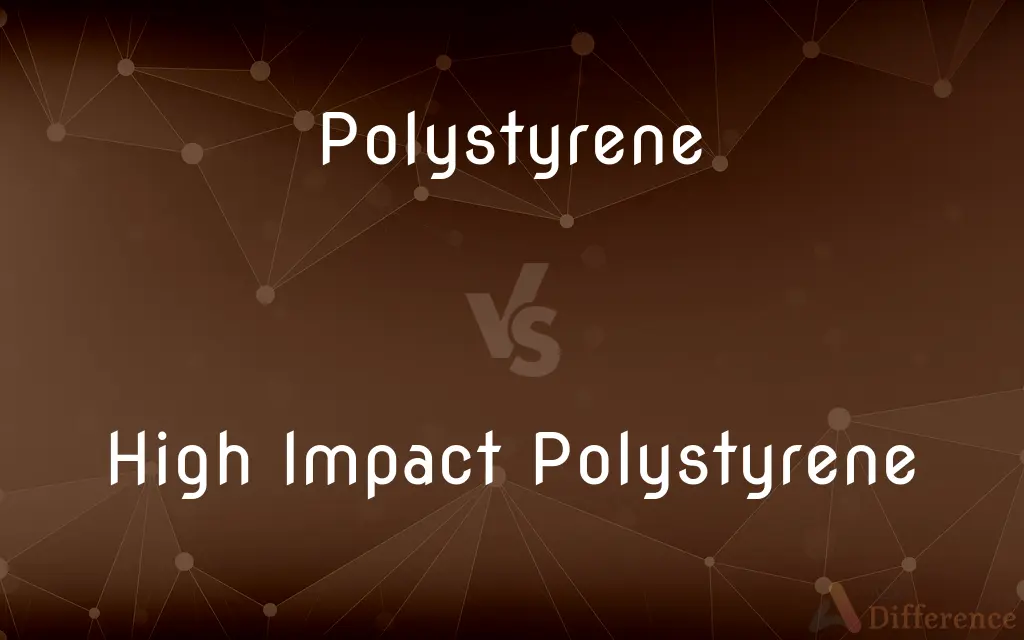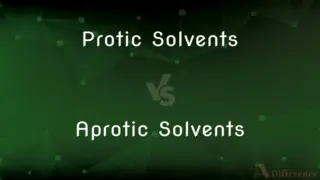Polystyrene vs. High Impact Polystyrene — What's the Difference?
Edited by Tayyaba Rehman — By Urooj Arif — Published on February 22, 2024
Polystyrene is a lightweight, rigid plastic used in various applications, while High Impact Polystyrene (HIPS) is a tougher version of polystyrene, enhanced with polybutadiene rubber to improve its impact resistance.

Difference Between Polystyrene and High Impact Polystyrene
Table of Contents
ADVERTISEMENT
Key Differences
Polystyrene (PS) is a versatile plastic polymer made from styrene monomers, known for its clarity, rigidity, and insulation properties. It is widely used in packaging, disposable containers, and insulation materials. PS is inexpensive and easy to manufacture, but it is brittle and prone to cracking under impact.
High Impact Polystyrene (HIPS), on the other hand, is a blend of polystyrene and polybutadiene rubber, which significantly increases its toughness. The addition of rubber makes HIPS less brittle and more resistant to impact than standard polystyrene, without significantly compromising the material's inherent properties such as ease of use and manufacturability. HIPS finds applications in products that require a higher degree of durability, such as appliance housings, toy parts, and automotive components.
Both PS and HIPS share similar chemical foundations, the key difference lies in their mechanical properties. But HIPS offers enhanced impact resistance, making it suitable for a wider range of applications where durability is critical. However, this comes at the cost of slight reductions in clarity and rigidity compared to pure polystyrene.
The manufacturing process for HIPS involves blending polystyrene with polybutadiene in a way that the rubber particles are finely dispersed throughout the polystyrene matrix. This dispersion is what gives HIPS its improved impact resistance. The process allows for the tuning of the material's properties by adjusting the amount of rubber added, providing manufacturers with flexibility in balancing toughness with other desired characteristics.
In terms of environmental impact, both PS and HIPS pose challenges in recycling and biodegradability. However, their widespread use in various industries makes understanding and improving their environmental footprint a significant area of research and development.
ADVERTISEMENT
Comparison Chart
Composition
Made from styrene monomers
Polystyrene blended with polybutadiene rubber
Impact Resistance
Brittle and prone to cracking
Enhanced impact resistance due to rubber addition
Applications
Packaging, disposable containers, insulation
Appliance housings, toy parts, automotive components
Clarity
High clarity, transparent
Slightly reduced clarity due to rubber particles
Rigidity
Very rigid
Slightly less rigid than PS due to flexibility from rubber
Environmental Impact
Difficult to recycle and not biodegradable
Similar challenges in recycling and biodegradability, with added complexity due to rubber component
Manufacturing Process
Polymerization of styrene
Blending of polystyrene with polybutadiene rubber
Compare with Definitions
Polystyrene
Known for its insulation properties in building construction.
Polystyrene foam is often used as insulation in walls and roofs.
High Impact Polystyrene
Used in automotive components for its toughness.
Some interior car parts are fabricated from HIPS for durability.
Polystyrene
Commonly used in packaging for its protective qualities.
Electronics are frequently packed in polystyrene foam to prevent damage during shipping.
High Impact Polystyrene
Can be easily colored and molded.
HIPS is preferred for creating durable, colorful household items.
Polystyrene
A clear, rigid plastic used for making disposable cutlery and CD cases.
The clear disposable cups at the party were made of polystyrene.
High Impact Polystyrene
Offers better impact resistance than standard polystyrene.
Children's toys made from HIPS can withstand rough play without breaking.
Polystyrene
Easily molded into different shapes.
Polystyrene is used to create intricate models and prototypes.
High Impact Polystyrene
A durable plastic used for making toy parts and appliance housings.
The housing of the remote control was made from high impact polystyrene.
Polystyrene
Lightweight and cost-effective material.
Polystyrene is favored for lightweight packaging solutions to reduce shipping costs.
High Impact Polystyrene
Balances rigidity with impact resistance.
HIPS is used in packaging that requires a degree of flexibility to absorb impacts.
Polystyrene
A rigid clear thermoplastic polymer of styrene that can be molded into objects or made into a foam that is used as thermal insulation.
Polystyrene
(organic chemistry) An alkane chain of benzene molecules, RCH2CHphenylR.
Common Curiosities
Are there environmental concerns associated with using Polystyrene and High Impact Polystyrene?
Yes, both materials are challenging to recycle and not biodegradable, posing environmental concerns regarding waste and sustainability.
What makes High Impact Polystyrene different from regular Polystyrene?
The main difference is the addition of polybutadiene rubber to HIPS, enhancing its impact resistance and toughness compared to regular polystyrene.
How do the costs of PS and HIPS compare?
HIPS generally costs more than PS due to the additional processing and materials (such as polybutadiene rubber) required to enhance its impact resistance. However, the cost difference can be justified by the need for higher durability in certain applications.
Can Polystyrene and High Impact Polystyrene be recycled together?
While both can be recycled, their different compositions mean they should be processed separately to maintain the quality of the recycled material.
Can HIPS be used in food packaging similarly to PS?
Yes, HIPS can be used in food packaging, especially for products requiring sturdier containers. However, PS is more commonly used for typical food packaging due to its clarity and cost-effectiveness.
Can PS and HIPS withstand high temperatures?
PS and HIPS can withstand temperatures up to a certain point before becoming soft. HIPS offers slightly better thermal stability due to the polybutadiene rubber, but both materials are not suitable for high-temperature applications.
Why is High Impact Polystyrene used in automotive components?
HIPS is used in automotive components for its improved toughness and impact resistance, making it suitable for parts that require durability.
How does the presence of polybutadiene rubber in HIPS affect its properties?
Polybutadiene rubber makes HIPS less brittle and more resistant to impact, though it may slightly reduce the material's clarity and rigidity.
What are the main processing methods for PS and HIPS?
Both PS and HIPS can be processed through common methods such as injection molding, extrusion, and thermoforming. The choice of processing method depends on the desired product characteristics and application.
How does the durability of HIPS compare to other plastics?
HIPS is more durable than many other plastics when it comes to impact resistance. However, materials like polycarbonate or certain polyamides may offer higher strength and toughness for more demanding applications.
How does the addition of polybutadiene rubber affect the color and transparency of HIPS?
The inclusion of polybutadiene rubber in HIPS results in a reduction of its clarity and can affect its color, making it less transparent and slightly more opaque than PS. However, HIPS can still be colored or made relatively translucent for various applications.
Is there a difference in the environmental impact of PS and HIPS?
Both materials pose environmental challenges in terms of recycling and biodegradability. The rubber component in HIPS can complicate recycling processes, potentially making its environmental impact slightly higher than PS.
What innovations are being explored to make PS and HIPS more environmentally friendly?
Innovations include developing more efficient recycling methods, creating biodegradable alternatives, and enhancing the sustainability of production processes. Efforts are also focused on incorporating recycled material back into new products.
Are there any health concerns associated with using PS and HIPS?
Both PS and HIPS are considered safe for many applications, including packaging. However, there are concerns about the migration of styrene (a component of PS) into food and beverages from containers made with PS. Regulatory bodies set strict limits on styrene migration to ensure safety.
Are PS and HIPS resistant to chemicals?
Both PS and HIPS have moderate resistance to acids, alkalis, and some solvents, but they can be attacked by strong solvents and oils. Their chemical resistance makes them suitable for various applications, though not as resilient as some specialty plastics.
Share Your Discovery

Previous Comparison
Protic Solvents vs. Aprotic Solvents
Next Comparison
Belt Transect vs. Line TransectAuthor Spotlight
Written by
Urooj ArifUrooj is a skilled content writer at Ask Difference, known for her exceptional ability to simplify complex topics into engaging and informative content. With a passion for research and a flair for clear, concise writing, she consistently delivers articles that resonate with our diverse audience.
Edited by
Tayyaba RehmanTayyaba Rehman is a distinguished writer, currently serving as a primary contributor to askdifference.com. As a researcher in semantics and etymology, Tayyaba's passion for the complexity of languages and their distinctions has found a perfect home on the platform. Tayyaba delves into the intricacies of language, distinguishing between commonly confused words and phrases, thereby providing clarity for readers worldwide.
















































